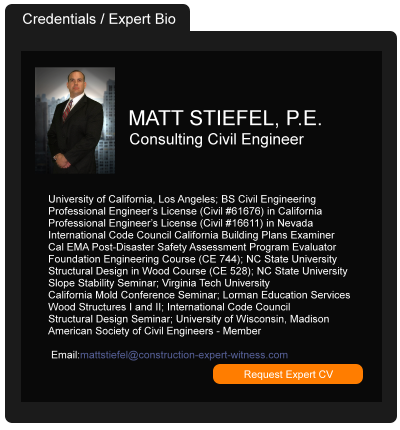Home Repair Firms Sued for Fraud
September 30, 2011 —
CDJ STAFFThe Illinois Attorney General has filed a lawsuit in Cook County Circuit Court alleging that two connected firms took money from homeowners and then failed to perform the contracted work. One of the three defendants, Chris Bidigare, was an owner of agent of both Fairway Construction and Maintenance Services, LLC, and Rock Construction Management, LLC.
In once case, according to the article on the OakPark Patch, one homeowner provided a $111,000 down payment, only to have the company cancel the job and refuse to return the money. One homeowner was told by Fairway that she should contact their insurance provider. The insurance provider told her that Fairway’s insurance had been cancelled due to non-payment.
The suit seeks to bar the three defendants from working in home repair in Illinois.
Read the full story…
Read the court decisionRead the full story...Reprinted courtesy of
Limiting Liability: Three Clauses to Consider in your Next Construction Contract
June 25, 2019 —
Tara Lynch - Gordon & Rees Construction Law BlogIn your next contract, consider including some (or all!) of the following clauses to limit your liability and maximize your profits.
Waiver of Consequential Damages
While a proven breach of contract will leave a design professional or contractor exposed to direct or compensatory damages, a waiver of consequential damages will help “stop the bleeding” and protect the design professional or contractor from paying every damage that might flow from the breach. Consequential damages include those damages which indirectly flow from the breach of contract, for example, lost rents, lost profits, lost use, lost opportunity, loss of employee productivity, and damages to reputation.
The American Institute of Architects (AIA) has included a mutual waiver of consequential damages in its sample A201 for over 20 years. The AIA provision includes a definition of consequential damages which are waived, including many of the examples cited above. However, the AIA waiver of consequential damages clause carves out an exception for liquidated damages to the owner. Prudent design professionals and contractors will strike this exception so as not to render the clause meaningless. A well-drafted waiver clause will be mutual, will define which damages are consequential versus direct, and will not contain exceptions.
Read the court decisionRead the full story...Reprinted courtesy of
Tara Lynch - Gordon & Rees Scully MansukhaniMs. Lynch may be contacted at
tlynch@grsm.com
Court Concludes That COVID-19 Losses Can Qualify as “Direct Physical Loss”
September 28, 2020 —
Lorelie S. Masters & Jorge R. Aviles - Hunton Andrews KurthIn a victory for policyholders, a federal district court found that COVID-19 can cause physical loss under business-interruption policies. In Studio 417, Inc., et al. v. The Cincinnati Insurance Co., No. 20-cv-03127-SRB (W.D. Mo. Aug. 12, 2020), the court rejected the argument often advanced by insurers that “all-risks” property insurance policies require a physical, structural alteration to trigger coverage. This decision shows that, with correct application of policy-interpretation principles and strategic use of pleading and evidence, policyholders can defeat the insurance industry’s “party line” arguments that business-interruption insurance somehow cannot apply to pay for the unprecedented losses businesses are experiencing from COVID-19, public-safety orders, loss of use of business assets, and other governmental edicts.
The policyholders in Studio 417 operate hair salons and restaurants asserting claims for business interruption. In suing to enforce their coverage, the policyholders allege that, over the last several months, it is likely that customers, employees, and/or other visitors to the insured properties were infected with COVID-19 and thereby infected the insured properties with the virus. Their complaint asserts that the presence of COVID-19 “renders physical property in their vicinity unsafe and unusable.” Unlike some other complaints seeking to enforce such coverage, it also alleges that the presence of COVID-19 and government “Closure Orders” “caused a direct physical loss or direct physical damage” to their premises “by denying use of and damaging the covered property, and by causing a necessary suspension of operations during a period of restoration.”
Reprinted courtesy of
Lorelie S. Masters, Hunton Andrews Kurth and
Jorge R. Aviles, Hunton Andrews Kurth
Ms. Masters may be contacted at lmasters@HuntonAK.com
Mr. Aviles may be contacted at javiles@HuntonAK.com
Read the court decisionRead the full story...Reprinted courtesy of
It Has Started: Supply-Chain, Warehouse and Retail Workers of Essential Businesses Are Filing Suit
June 22, 2020 —
Robert G. Devine, James Burger & Douglas Weck - White and Williams LLPSupply-chain businesses that are appropriately characterized as “essential” have remained open for the delivery of critical supplies while everyone else has been told to close up shop and stay home. Now essential-business employees are contracting COVID-19 and filing suit. Following up on our earlier piece — “Is a Violation of a COVID-19 Order the Basis For Civil Liability?” — it is important to recognize that government directives, oftentimes couched as “recommendations,” can come to define what it means to provide a reasonably safe workplace that protects employees from COVID-19. While common law negligence defenses consider the reasonableness of conduct, these directives will likely become the standard.
The cases that have been filed are overwhelmingly premised upon the timeless negligence construct. The negligence construct, simply put, imposes a duty to act as a reasonable person would under the circumstances. Nonetheless, while the negligence construct lives in the ordinary world of “reasonableness,” infection-control guidance lives in the rapidly developing world of the science of COVID-19. Guidance on seemingly basic questions, such as the methods of transmission (e.g., personal contact, mucus membrane only, airborne transmission) or even the virus’s shelf life on different surfaces, of particular interest packaging and material handling equipment, can change by the day. All of this provides challenges for the supply-side business looking to protect its workforce.
Reprinted courtesy of White and Williams LLP attorneys
James Burger,
Robert Devine and
Douglas Weck
Mr. Burger may be contacted at burgerj@whiteandwilliams.com
Mr. Devine may be contacted at deviner@whiteandwilliams.com
Mr. Weck may be contacted at weckd@whiteandwilliams.com
Read the court decisionRead the full story...Reprinted courtesy of
New York State Legislature Passes Legislation Expanding Wrongful Death Litigation
July 18, 2022 —
Lisa M. Rolle & Justyn Verzillo - Traub LiebermanIn early June, New York State Legislature passed legislation, often referred to as “The Grieving Families Act” (A.6770/S.74-A), which expands New York’s Wrongful Death Statute. This legislation is pending approval from Governor Kathy Hochul and has the ability to drastically impact wrongful death litigation by expanding how parties can bring an action, as well as expanding on recoverable compensation.
Pursuant to the existing statute (EPTL §5-4.1), the statute of limitations requires commencement of an action within two years after the decedent’s death. The proposed Grieving Families Act expands the statute of limitations for a wrongful death action to three years and six months after the decedent’s death.
Further, under the existing statute (EPTL §11-3.3), recovery in a wrongful death action is restricted to distributees (the intended beneficiaries under the will). The proposed legislation expands the parties permitted to bring a wrongful death action, replacing the term distributees with surviving close family members. These may include, but are not limited to, spouse or domestic partner, issue, parents, grandparents, step-parents, and siblings, leaving it to the finder of fact to determine which persons are close family members of the decedent based upon the specific circumstances relating to the person’s relationship with decedent. It remains to be seen what the burden of proof will be for the surviving close family members, as well as what process will be instituted with respect to the finder of fact. Presumably, the finder of fact will be a Judge.
Reprinted courtesy of
Lisa M. Rolle, Traub Lieberman and
Justyn Verzillo, Traub Lieberman
Ms. Rolle may be contacted at lrolle@tlsslaw.com
Mr. Verzillo may be contacted at jverzillo@tlsslaw.com
Read the court decisionRead the full story...Reprinted courtesy of
New Rule Prohibits Use of Funds For Certain DoD Construction and Infrastructure Programs and Projects
May 30, 2018 —
Pillsbury's Construction & Real Estate Law Team - Gravel2Gavel Construction & Real Estate Law BlogRecently, our colleagues Glenn Sweatt and Alex Ginsberg published their Client Alert titled
DFARS Clause Blocks Funding for Unsafe Projects in Afghanistan, Recently published regulation implements the FY17 NDAA to prohibit use of funds for DoD construction and infrastructure programs and projects in Afghanistan that cannot be safely accessed by U.S. Government personnel. Takeaways include:
New rule prevents Government contracting officers from funding projects that are not able to be safely accessed by Government civilian or military personnel, as these may pose an increased risk of fraud, corruption or waste, or lack efficient oversight.
Read the court decisionRead the full story...Reprinted courtesy of
Pillsbury's Construction & Real Estate Law Team
Investing in Metaverse Real Estate: Mind the Gap Between Recognized and Realized Potential
May 10, 2022 —
Robert G. Howard, David W. Wright & Craig A. de Ridder - Gravel2Gavel Construction & Real Estate Law BlogThe Metaverse is an immersive world combining virtual reality and augmented reality, where users are represented by avatars and roam virtual spaces. It comprises a variety of platforms and environments that can be explored, experienced, and developed. Online social games like Second Life, Fortnite and Minecraft are among the first wave of successful Metaverse games. Now, Meta and Microsoft see the Metaverse as a place to play, live, and work. A JP Morgan white paper stated that opportunities in the Metaverse seem “limitless.” The bank predicted that virtual worlds will “infiltrate every sector in some ways in the coming years.” A March 31 report by Citi concluded that the Metaverse has the potential to become a $13 trillion opportunity by 2030, with total global users of between one and five billion. According to Citi, the Metaverse will become a significant part of the next iteration of the internet (referred to as Web3) enabled by a variety of existing and emerging technologies, including 5G connectivity, secure blockchain and payment platforms, crypto assets, cloud computing, artificial intelligence, 3D modeling tools and headset devices.
A Land Rush, Virtually Speaking
Not surprisingly, investors are speculating regarding the value and potential of “virtual land” within the Metaverse, where land sales in 2021 exceeded $500 million and attracted a lot of attention and hype. The Sandbox, Decentraland, Somnium Space and CryptoVoxels are the most active platforms and owners can build almost anything on their virtual parcels. The open-source Ethereum blockchain, with self-executing smart contract functionality, operates as the foundational layer for most platforms. Parcels of land in The Sandbox and Decentraland are purchased with cryptocurrencies (called SAND and MANA, respectively) on their platforms and can also be sold and purchased on secondary marketplaces like OpenSea.
Reprinted courtesy of
Robert G. Howard, Pillsbury,
David W. Wright, Pillsbury and
Craig A. de Ridder, Pillsbury
Mr. Howard may be contacted at robert.howard@pillsburylaw.com
Mr. Wright may be contacted at david.w.wright@pillsburylaw.com
Mr. Deridder may be contacted at craig.deridder@pillsburylaw.com
Read the court decisionRead the full story...Reprinted courtesy of
THE CALIFORNIA SUPREME COURT HAS RULED THAT THE RIGHT TO REPAIR ACT (SB800) IS THE EXCLUSIVE REMEDY FOR CONSTRUCTION DEFECT CLAIMS NOT INVOLVING PERSONAL INJURIES WHETHER OR NOT THE UNDERLYING DEFECTS GAVE RISE TO ANY PROPERTY DAMAGE in McMillin Albany LL
January 24, 2018 —
Chapman, Glucksman, Dean, Roeb, & BargerRICHARD H. GLUCKSMAN, ESQ.
GLENN T. BARGER, ESQ.
JON A. TURIGLIATTO, ESQ.
DAVID A. NAPPER, ESQ.
The Construction Industry finally has its answer. The California Supreme Court ruled that the Right to Repair Act (SB800) is the exclusive remedy for construction defect claims alleged to have resulted from economic loss, property damage, or both. Our office has closely tracked the matter since its infancy. The California Supreme Court’s holding resolves the split of authority presented by the Fifth Appellate District’s holding in
McMillin Albany LLC v. Superior Court (2015) 239 Cal.App.4th 1132, which outright rejected the Fourth Appellate District’s holding in
Liberty Mutual Insurance Co. v. Brookfield Crystal Cove LLC (2013) 219 Cal.App.4th 98.
By way of background, the Fourth District Court of Appeal held in
Liberty Mutual that compliance with SB800’s pre-litigation procedures prior to initiating litigation is only required for defect claims involving violations of SB800’s building standards that have not yet resulted in actual property damage. Where damage has occurred, a homeowner may initiate litigation under common law causes of action without first complying with the pre-litigation procedures set forth in SB800. Two years later, the Fifth District Court of Appeal, in
McMillin Albany, held that the California Legislature intended that all claims arising out of defects in new residential construction sold on or after January 1, 2003 are subject to the standards and requirements of the Right to Repair Act, including specifically the requirement that notice be provided to the builder prior to filing a lawsuit. Thus, the Court of Appeal ruled that SB800 is the exclusive remedy for all defect claims arising out of new residential construction sold on or after January 1, 2003.
After extensive examination of the text and legislative history of the Right to Repair Act, the Supreme Court affirmed the Fifth District Court of Appeal’s ruling that SB800 preempts common law claims for property damage. The Complaint at issue alleged construction defects causing both property damage and economic loss. After filing the operative Complaint, the homeowners dismissed the SB800 cause of action and took the position that the Right to Repair Act was adopted to provide a remedy for construction defects causing only economic loss and therefore SB800 did not alter preexisting common law remedies in cases where actual property damage or personal injuries resulted. The builder maintained that SB800 and its pre-litigation procedures still applied in this case where actually property damages were alleged to have occurred.
The Supreme Court found that the text and legislative history reflect a clear and unequivocal intent to supplant common law negligence and strict product liability actions with a statutory claim under the Right to Repair Act. Specifically the text reveals “…an intent to create not merely
a remedy for construction defects but
the remedy.” Additionally certain clauses set forth in SB800 “…evinces a clear intent to displace, in whole or in part, existing remedies for construction defects.” Not surprisingly, the Court confirmed that personal injury damages are expressly not recoverable under SB800, which actually assisted the Court in analyzing the intent of the statutory scheme. The Right to Repair Act provides that construction defect claims not involving personal injury will be treated the same procedurally going forward whether or not the underlying defects gave rise to any property damage.
The Supreme Court further found that the legislative history of SB800 confirms that displacement of parts of the existing remedial scheme was “…no accident, but rather a considered choice to reform construction defect litigation.” Further emphasizing how the legislative history confirms what the statutory text reflects, the Supreme Court offered the following summary: “the Act was designed as a broad reform package that would substantially change existing law by displacing some common law claims and substituting in their stead a statutory cause of action with a mandatory pre-litigation process.” As a result, the Supreme Court ordered that the builder is entitled to a stay and the homeowners are required to comply with the pre-litigation procedures set forth in the Right to Repair Act before their lawsuit may proceed.
The seminal ruling by the California Supreme Court shows great deference to California Legislature and the “major stakeholders on all sides of construction defect litigation” who participated in developing SB800. A significant win for builders across the Golden State, homeowners unequivocally must proceed via SB800 for all construction defect claims arising out of new residential construction sold on or after January 1, 2003. We invite you to contact us should you have any questions.
Reprinted courtesy of Chapman Glucksman Dean Roeb & Barger attorneys
Richard Glucksman,
Glenn Barger,
Jon Turigliatto and
David Napper
Mr. Glucksman may be contacted at rglucksman@cgdrblaw.com
Mr. Barger may be contacted at gbarger@cgdrblaw.com
Mr. Turgliatto may be contacted at jturigliatto@cgdrblaw.com
Mr. Napper may be contacted at dnapper@cgdrblaw.com
Read the court decisionRead the full story...Reprinted courtesy of


































































